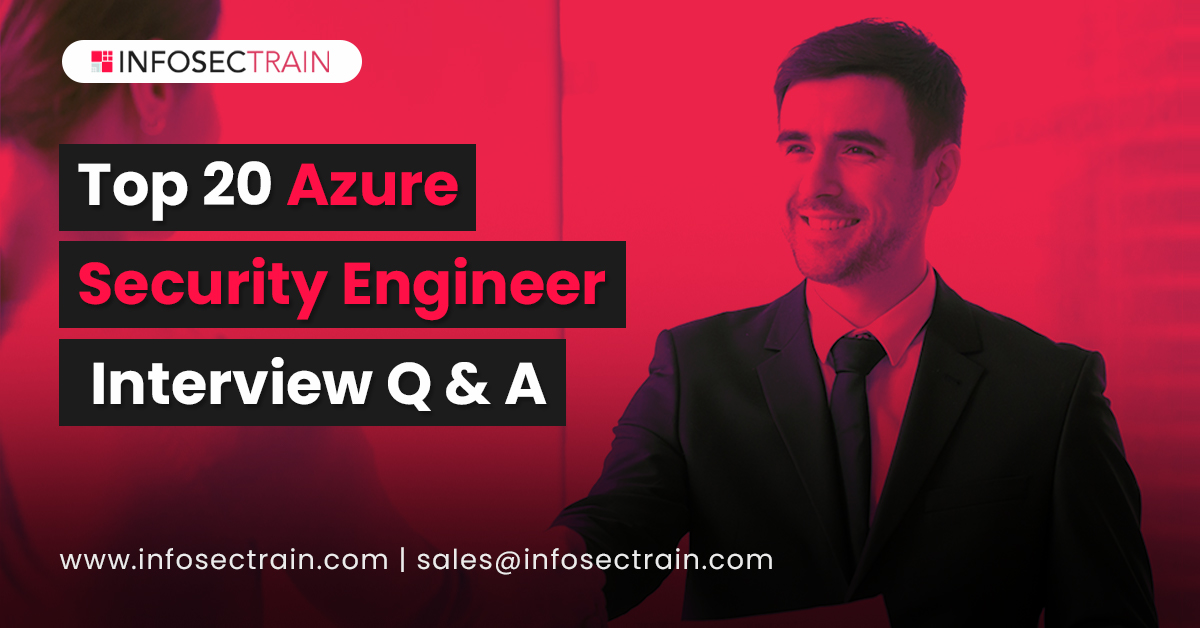Top 20 Azure Security Engineer Interview Questions and Answers
Microsoft Azure is the second most winning Cloud service provider on the lookout. Over 80% of the Fortune 500 organizations trust Microsoft Azure for their Cloud service obligations because of its convincing IaaS solutions. Along these lines, there are various corporations that are recruiting Azure certified specialists for several inside job postings. One of the significantly extraordinary and most preferred Azure occupation jobs is that of a Cloud Security Engineer. Security is an extremely important domain for any organization. This is the reason why Azure Security Engineers are in such high demand in the market.

On the off chance that you are among the candidates that are attempting to land a good profession as an Azure Security Engineer, then you should set yourself up well to get your dream job. Here is a log of 20 Azure Security Engineer job interview questions that are posed to an aspiring Azure Security Engineer that will take you forward on the accomplishment way.
Question 1: Define Microsoft Azure and its fundamental use.
Answer: There are certain companies in the market that provide the Cloud Service. One of them is Microsoft. So, Microsoft Azure is a Cloud Service Provider. It is mainly used for accessing Microsoft’s Infrastructure for Cloud services.
Question 2: Mention the Security features of the Cloud.
Answer: The main security features provide with Cloud are:
- Identity and Access Management: It is a framework of policies and technologies that ensures that all the employees of an organization have access to the technology. It incorporates features like AD, PIM, Conditional Access Policy, etc.
- Platform protection: It helps prevent file-based Malware attacks, detect malicious activity, and provide the investigation and remediation capabilities. It incorporates features like Azure firewall, Load balancer, DDoS protection, front door, etc.
- Security operation: It is a practice or team that is devoted to preventing, detecting, assessing, monitoring, and responding to cybersecurity threats and incidents. It incorporates features like Log analytic Workspace, Azure sentinel.
- Secure Data and Application: It is a process of protecting data from unauthorized access and data corruption throughout its lifecycle. It incorporates features like Azure key vault, Encryption, SAS, Service Identity etc.
Question 3: Define the implemented Security Laws to secure data in a Cloud.
Answer: The implemented Security Laws to secure the data in a Cloud are:
- Processing: It mainly controls the data that is being processed accurately and thoroughly in any application.
- File: It maintains and regulates the data that is being manipulated in any of the files.
- Output reconciliation: It manages the data that has to be reconciled from input to output.
- Input Validation: It controls the input data.
- Security and Backup: It delivers security and backup along with controlling the security breach logs.
Question 4: What are the services provided by Windows Azure Operating System?
Answer: There are three core services provided by Windows Azure Operating System given as:
- Compute
- Storage
- Management
Question 5: Mention the essential things to be taken into account by the users before moving to a Cloud Computing Platform.
Answer: The essential things to be taken into account are:
- Compliance
- Loss of data
- Data storage
- Business continuity
- Uptime
- Data integrity in cloud computing
Question 6: What are the different layers defining the Cloud architecture?
Answer: The different layers that define the Cloud architecture are:
- CLC or Cloud Controller
- Walrus
- Cluster Controller
- SC or Storage Controller
- NC or Node Controller
Question 7: How can you secure your data for transport in the cloud?
Answer: In order to secure your data during transportation from one place to another, ensure there is no leakage with the encryption key applied to the data that you are sending.
Question 8: Define a Storage Key.
Answer: The ‘Storage Account Keys’ are like root passwords for your storage accounts. You must be careful to defend your access keys. You can use Azure Key Vault to manage and rotate your keys securely. Azure Portal, Powershell, and Azure CLI can help you in viewing and copying your account access keys.
Question 9: Define Network Security Groups.
Answer: Network Security Groups are abbreviated as NSGs, incorporate a list of rules of Access Control List (ACL) that either allow or deny network traffic to subnets, NICs, or both. NSGs are often correlated with subnets or single NICs connected to a subnet. The ACL rules will apply to all the VMs in the subnet that is associated with an NSG. Also, the traffic to an individual NIC can be restrained when an NSG is directly associated with a NIC.
Question 10: Define Azure Security Center.
Answer: Azure Security Center is a consolidated infrastructure security management framework that reinforces the security posture of your data centers, and offers advanced threat protection across your hybrid tasks in the cloud – if they’re in Azure or not – just as on-premises. Azure Security Center equips you with the proper tools expected to solidify your network, secure your services and ensure that you’re on top of your security position.
Question 11: How does Azure Security Center help in improving the security infrastructure?
Answer: Azure Security Center strengthens the security posture by helping you identify and perform the solidifying tasks recommended as security best practices and execute them across your machines, data services, and apps. This incorporates managing and enforcing your security approaches, and ensuring your Azure virtual machines, non-Azure servers, and Azure PaaS services are compliant. It also offers the tools you need to have for an aerial perspective on your workloads, along with focused visibility on your network security estate.
Question 12: What will happen if you exhaust the maximum failed attempts for authenticating yourself via Azure AD?
Answer: We use a complex technique to secure accounts. This entirely depends on the IP address of the application and the passwords mentioned. The duration of the lockout likewise increases based on the probability that it is an attack. We can also enforce Password Change and MFA as per the policy.
Question 13: Define the Azure Security Policies.
Answer: A security policy specifies the aspired arrangement of your workloads and supports in making sure that you’re complying with the security obligations of your corporation or regulators.
Azure Security Center proffers its security suggestions based on your preferred policies. Security Center policies are dependent on policy initiatives designed in Azure Policy. You can use it to maintain your policies and to set policies across Management groups and across multiple subscriptions. There are options offered by Security Center to work with Security Policies:
- View and edit the built-in default policy
- Add your own custom policies
- Add regulatory compliance policies
Question 14: What is Network Access Control?
Answer: Network Access Control also referred to as NAC, is the act of controlling connectivity to and from specific devices or subnets within a virtual network. Its purpose is to allow access to your virtual machines and services, only to the approved users and devices. Access controls are dependent on choices to allow or deny connections to and from your virtual machine or service.
Azure supports various sorts of network access control, like:
- Network layer control
- Route control and forced tunneling
- Virtual network security appliances
Question 15: How will you define Azure Network Security?
Answer: Network security could be characterized as the way of protecting resources from unapproved access or assault by applying controls to network traffic. Its main intention is to make sure that only legitimate traffic is permitted. Azure incorporates a vigorous networking infrastructure to help your application and service connectivity necessities. Network connectivity is conceivable between resources situated in Azure, between on-premises and Azure-hosted resources, and to and from the web and Azure.
Question 16: Mention the challenges addressed by Azure Security Center.
Answer: Azure Security Center mostly addresses these three urgent security challenges:
- Rapidly changing workloads: This is a strength of the cloud as well as a challenge.
- Increasingly sophisticated attacks: Wherever you execute your workloads, the attacks keep getting more sophisticated. You need to secure your public cloud workloads, which are an Internet-facing workload, that can leave you more exposed if you don’t follow security best practices.
- Security skills are in short supply: The quantity of security alerts and alerting systems far dwarfs the number of administrators with the fundamental foundation and experience to ensure your surroundings are secured. Staying up-to-date with the recent assaults is a constant challenge, making it difficult to stay in place while the world of security is steadily evolving.
Question 17: How can Azure Security Center help you in protecting against security challenges?
Answer: Azure Security Center offers you the tools to help you protect against the security challenges:
- Strengthen security posture: Security Center evaluates your surroundings and equips you to know the status of your resources, and if they are secure.
- Protect against threats: Security Center evaluates your workloads and raises threat prevention support and security alerts.
- Get secure faster: In the Security Center, everything is done at cloud speed. Since it is natively incorporated, deployment of Security Center is simple, giving you auto-provisioning and protection with Azure services.
Question 18: Define encryption of Data at rest.
Answer: Data at rest incorporates information that resides in resolute storage on physical media, in any digital format. The media can accommodate files on magnetic or optical media, archived data, and data backups. So, Data Encryption at rest is designed to prevent the attacker from accessing the unencrypted data by making sure the data is encrypted when on disk. Data encryption at rest is accessible for services across the cloud models like Software as a Service (SaaS), Platform as a Service (PaaS), and Infrastructure as a Service (IaaS).
Question 19: Mention the Azure Encryption models.
Answer: There are many Azure Encryption models:
- Client-side encryption
- Server-side encryption
- Azure disk encryption
- Azure Storage Service Encryption
- Client-side encryption of Azure blobs
- Data at rest encryption with Azure SQL Database
- Cosmos DB database encryption
- At-rest encryption in Data Lake
Question 20: Define Advanced Threat Protection.
Answer: Advanced Threat Protection is examining your logs to identify anomalous performance and potentially malicious efforts to access or exploit databases. Alerts are generated for suspicious activities such as SQL injection, potential data infiltration, and brute force attacks or for anomalies in access patterns to catch privilege escalations and breached credentials use. Alerts are viewed from the Azure Security Center, where the specifics of the suspicious activities are implemented and recommendations for further investigation provided along with actions to mitigate the threat.
You can start your training for the Azure Security Engineer interview. To land up a favorable Azure Security Engineer job you must be well prepared before you can qualify for the interview. You can likewise focus to get your hands on the Azure Security expert certification to assemble your chances of finding a decent profession. In this series of events, you can check training and certification courses for the Microsoft AZ-500 Certification: Azure Security Technologies Training & Certification. Commence the preparation now if you want to propel your profession as an Azure Security Engineer.




 1800-843-7890 (India)
1800-843-7890 (India) 
